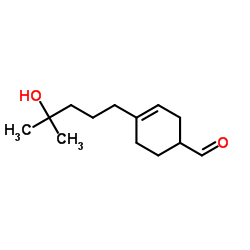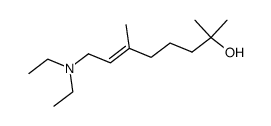4-(4-Hydroxy-4-methylpentyl)cyclohex-3-enecarbaldehyde

4-(4-Hydroxy-4-methylpentyl)cyclohex-3-enecarbaldehyde structure
|
Common Name | 4-(4-Hydroxy-4-methylpentyl)cyclohex-3-enecarbaldehyde | ||
|---|---|---|---|---|
| CAS Number | 31906-04-4 | Molecular Weight | 210.313 | |
| Density | 1.0±0.1 g/cm3 | Boiling Point | 318.7±42.0 °C at 760 mmHg | |
| Molecular Formula | C13H22O2 | Melting Point | N/A | |
| MSDS | Chinese USA | Flash Point | 135.1±20.5 °C | |
| Name | 4-(4-hydroxy-4-methylpentyl)cyclohex-3-ene-1-carbaldehyde |
|---|---|
| Synonym | More Synonyms |
| Density | 1.0±0.1 g/cm3 |
|---|---|
| Boiling Point | 318.7±42.0 °C at 760 mmHg |
| Molecular Formula | C13H22O2 |
| Molecular Weight | 210.313 |
| Flash Point | 135.1±20.5 °C |
| Exact Mass | 210.161987 |
| PSA | 37.30000 |
| LogP | 2.53 |
| Vapour Pressure | 0.0±1.5 mmHg at 25°C |
| Index of Refraction | 1.528 |
| Storage condition | 2-8°C |
CHEMICAL IDENTIFICATION
HEALTH HAZARD DATAACUTE TOXICITY DATA
|
| Personal Protective Equipment | Eyeshields;Gloves |
|---|---|
| Hazard Codes | Xi |
| RIDADR | NONH for all modes of transport |
| WGK Germany | 2 |
| RTECS | GW2850000 |
| HS Code | 2912491000 |
|
~% 
4-(4-Hydroxy-4-... CAS#:31906-04-4 |
| Literature: Chemistry Letters, , p. 157 - 160 |
|
~92% 
4-(4-Hydroxy-4-... CAS#:31906-04-4 |
| Literature: Kumobayashi, Hidenori; Mitsuhashi, Shigeru; Akutagawa, Susumu; Ohtsuka, Sei Chemistry Letters, 1986 , p. 157 - 160 |
|
~% 
4-(4-Hydroxy-4-... CAS#:31906-04-4 |
| Literature: Chemistry Letters, , p. 157 - 160 |
| Precursor 4 | |
|---|---|
| DownStream 0 | |
| HS Code | 2912491000 |
|---|---|
| Summary | 2912491000. other aldehyde-alcohols. VAT:17.0%. Tax rebate rate:13.0%. . MFN tariff:5.5%. General tariff:30.0% |
|
Enhanced sensitization and elicitation responses caused by mixtures of common fragrance allergens.
Contact Dermatitis 65(6) , 336-42, (2011) Perfumes are complex mixtures composed of many fragrance ingredients, many of which are known to be only weak allergens when tested individually. It is therefore surprising that fragrance contact alle... |
|
|
Can exposure limitations for well-known contact allergens be simplified? An analysis of dose-response patch test data.
Contact Dermatitis 64(6) , 337-42, (2011) Allergic contact dermatitis is triggered by chemicals in the environment. Primary prevention is aimed at minimizing the risk of induction, whereas secondary and tertiary prevention are aimed at reduci... |
|
|
Experimental elicitation with hydroxyisohexyl-3-cyclohexene carboxaldehyde-containing deodorants.
Contact Dermatitis 56(3) , 146-50, (2007) Hydroxyisohexyl-3-cyclohexene carboxaldehyde (HICC) known as Lyral is a frequent allergen. It is used in more than 50% of marketed deodorants. The aim of the present study was to determine elicitation... |
| MFCD00019423 |
| 4-(4-Hydroxy-4-methylpentyl)-3-cyclohexene-1-carboxaldehyde |
| 4-(4-Hydroxy-4-methylpentyl)cyclohex-3-enecarbaldehyde |
| 4-(4-hydroxy-4-methylpentyl)-cyclohex-3-ene-1-carbaldehyde |
| Hydroxymethylpentylcyclohexenecarboxaldehyde |
| 3-Cyclohexene-1-carboxaldehyde, 4-(4-hydroxy-4-methylpentyl)- |
| 4-(4-Hydroxy-4-methylpentyl)-1-cyclohex-3-enecarboxaldehyde |
| 4-(4-hydroxy-4-methylpentyl)-3-cyclohexenecarboxaldehyde |
| Landolal |
| Kovanol |
| Lyral |
| 4-(4-Hydroxy-4-methylpentyl)-3-cyclohexene-1-carbaldehyde |
| 3-Cyclohexene-1-carboxaldehyde,4-(4-hydroxy-4-methylpentyl) |
| 4-(4'-hydroxy-4'-methylpentyl)-3-cyclohexene carbaldehyde |
| EINECS 250-863-4 |





